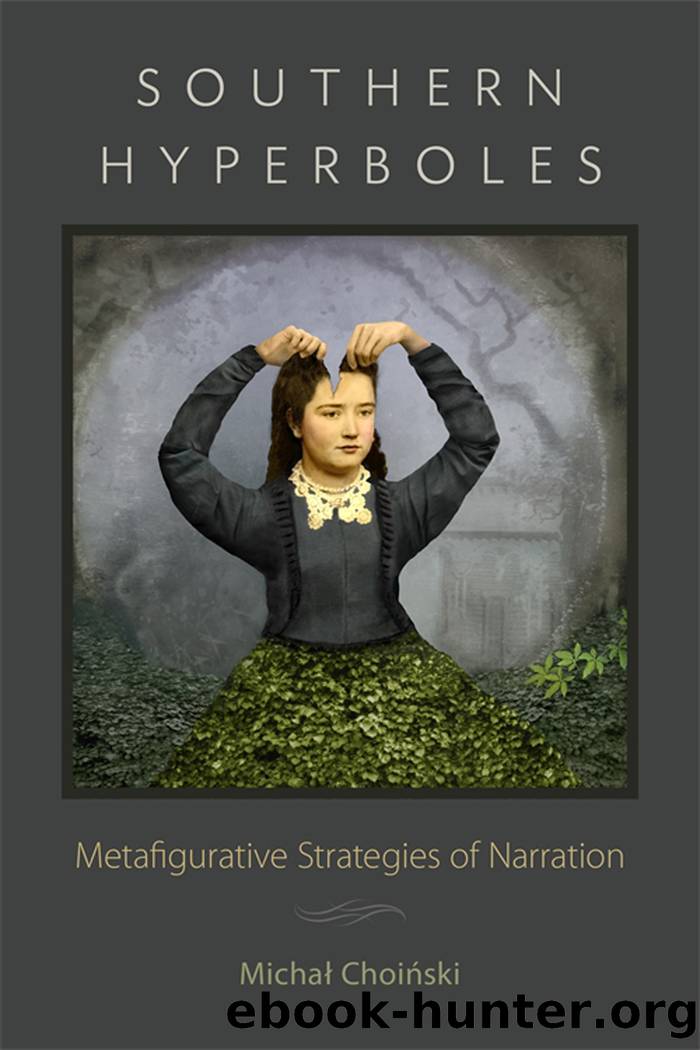Southern Hyperboles by Michał Choiński

Author:Michał Choiński
Language: eng
Format: epub
Publisher: LSU Press
Published: 2020-07-15T00:00:00+00:00
5
HYPERBOLIC DISSOLUTION
Tennessee Williams
In his foreword to Carson McCullers’s second novel, Reflections in a Golden Eye, Tennessee Williams discusses the gothic tradition of the American South. He stipulates that there is “something in the blood and culture” of the region that has triggered both an “emotional” interest in the “morbid” side of human nature and a sense of “dreadfulness in modern experience” (New Selected Essays 48–49). A number of Williams’s early texts flirt with this kind of aesthetic and evince the hyperbolic metalogic that is put under scrutiny in this book; this is also true of their “plastic” dramatic design. Williams’s interest in “morbid,” repressed desires, mixed with a semiautobiographical framework, allowed him to render the wounded and broken world interred in his texts particularly haunting. By debunking prescriptive social conventions and scandalizing cultural opposites, the playwright manages to come up with rules of artistic engagement that mesmerize, shock, and puzzle.
In this chapter, I seek to study the hyperbolic metalogic in Williams’s four early plays by exploring how different southern belles, trademark characters of his drama, collapse under hyperbolic tensions and how their forced evictions to mental institutions come to represent the destructive effect of excess. Williams’s hyperbolic is thus a detrimental force—it testifies to the ruinous effect of the repressive decorum and completely consumes his female characters. Since, through its violent metalogic, the playwright recreates the drama of what happened to his sister, Rose, this chapter opens with a discussion of Rose as a haunting motif in his oeuvre. Next, departing from Williams’s problematic relationship with Rose and her struggle with mental illness, I will look into the metaphoric disparity between John Buchanan and Alma Winemiller in Summer and Smoke to show how the playwright designs the metafigurative framework of his drama, preparing the way for the hyperbolic clash. Finally, I will discuss three cases of female characters who are removed to institutions due to their advancing mental disarray: Bertha from Hello from Bertha, Miss Collins from Portrait of a Madonna, and, the most famous of them all, Blanche DuBois from A Streetcar Named Desire.
One can hardly dissever Williams’s embattled fiction from his embattled life. The playwright himself was well aware of that synergy, and in his Memoirs he asked his readers provocatively, “Shall I attempt to entertain you, now, with my theatre or my life, assuming that there is much difference between them?” (108). The tale of Williams’s life has been told a number of times, and there are hardly any stones left unturned there, especially after the publication of Lyle Leverich’s landmark Tom: The Unknown Tennessee Williams, complemented recently by John Lahr’s Tennessee Williams: Mad Pilgrimage of the Flesh. Also, a number of adjacent, focalized studies, like John Bak’s biography of Williams as an artist, Tennessee Williams: A Literary Life, uncover the diverse minutiae of the playwright’s life. The overall image that emerges from all these publications is of a deeply wounded mind. He grew up in a household scarred by the mismatched marriage of his parents, in
Download
This site does not store any files on its server. We only index and link to content provided by other sites. Please contact the content providers to delete copyright contents if any and email us, we'll remove relevant links or contents immediately.
| Ancient & Classical | Arthurian Romance |
| Beat Generation | Feminist |
| Gothic & Romantic | LGBT |
| Medieval | Modern |
| Modernism | Postmodernism |
| Renaissance | Shakespeare |
| Surrealism | Victorian |
4 3 2 1: A Novel by Paul Auster(11047)
The handmaid's tale by Margaret Atwood(6852)
Giovanni's Room by James Baldwin(5877)
Big Magic: Creative Living Beyond Fear by Elizabeth Gilbert(4723)
Asking the Right Questions: A Guide to Critical Thinking by M. Neil Browne & Stuart M. Keeley(4574)
On Writing A Memoir of the Craft by Stephen King(4213)
Ego Is the Enemy by Ryan Holiday(3991)
Ken Follett - World without end by Ken Follett(3972)
The Body: A Guide for Occupants by Bill Bryson(3800)
Bluets by Maggie Nelson(3709)
Adulting by Kelly Williams Brown(3669)
Guilty Pleasures by Laurell K Hamilton(3586)
Eat That Frog! by Brian Tracy(3514)
White Noise - A Novel by Don DeLillo(3434)
The Poetry of Pablo Neruda by Pablo Neruda(3366)
Alive: The Story of the Andes Survivors by Piers Paul Read(3310)
The Bookshop by Penelope Fitzgerald(3225)
The Book of Joy by Dalai Lama(3217)
Fingerprints of the Gods by Graham Hancock(3212)
